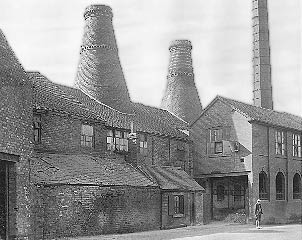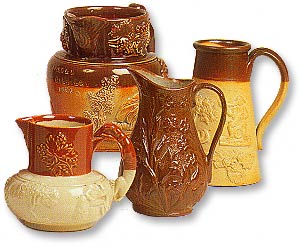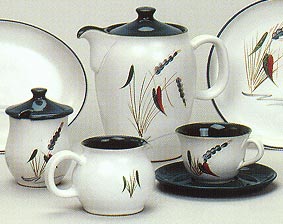|
NZ OWNED & OPERATED - FREE SHIPPING NATIONWIDE
|
Denby History
| In 1806, when a seam of clay was found at Denby in Derbyshire, England during the construction of a road, William Bourne, a local entrepreneur, examined the clay and recognised its exceptional qualities. Production of salt-glazed pottery began at Denby in 1809, and William gave the task of running the business to his youngest son, Joseph. Known as 'Joseph Bourne', the pottery prospered and soon built an international reputation for its quality bottles and jars, which could hold anything from ink, polish and medicines to preserves and even ginger beer. Salt glazing was a popular method of decorating stoneware at this time. Common salt was thrown onto the kiln fires when the embers were at their hottest. The salt vapour combined with the surface of the pot to produce a shiny brown surface coating. By the late 1800's glass bottles became less expensive and replaced ceramic containers. Denby Pottery diversified by extending its kitchenware range and developed richly coloured glazes which were to become Denby's trade mark. By the 1920's Denby's functional kitchenware (from pie dishes, jelly moulds and colanders to 'hot water bottles') could be found in many homes along with decorative vases, bowls and tobacco jars which were all stamped 'Danesby Ware'. This was the generic name given by Denby Pottery to all its decorative and giftware ranges. In the 1920's and 1930's 'Electric Blue' (shiny blue) and 'Orient ware' (matt blue/brown) became classic giftware ranges and today are popular with collectors. Kitchenware too became more colourful. Radical steps to change Denby's product range were taken in the 1950's when the pottery became predominantly a producer of dinnerware (ranges now included cups, saucers and plates). Denby continued to employ the best designers to ensure the transition was successful and this expertise produced best selling patterns such as Greenwheat (1956), Echo and Ode (1950's), Studio (1961) and Arabesque (1964). The 1970's brought a revolution in 'oven-to-tableware' - Denby's striking designs and practicality alleviated the need for separate cooking dishes and more decorative plates for serving, as Denby could withstand oven temperatures. By the 1980's 'casual dining' became more popular and ranges such as Imperial Blue and Regency Green were able to fit into both formal entertaining and family gatherings. Denby continues to build on its proud heritage with contemporary ranges such as Energy, Linen and Azure which reflect today's informal style. The company owes much of its present success to the skills of earlier generations of craftsmen. Most importantly, Denby has not lost sight of the reasons for its popularity as generations have grown to expect leading designs combined with a tradition of quality and durability. |
 Historic Denby 'beehive' kilns, early 19th century  Salt glazed jugs, early 1800s  'Greenwheat' hand-painted tableware c.1956 |


